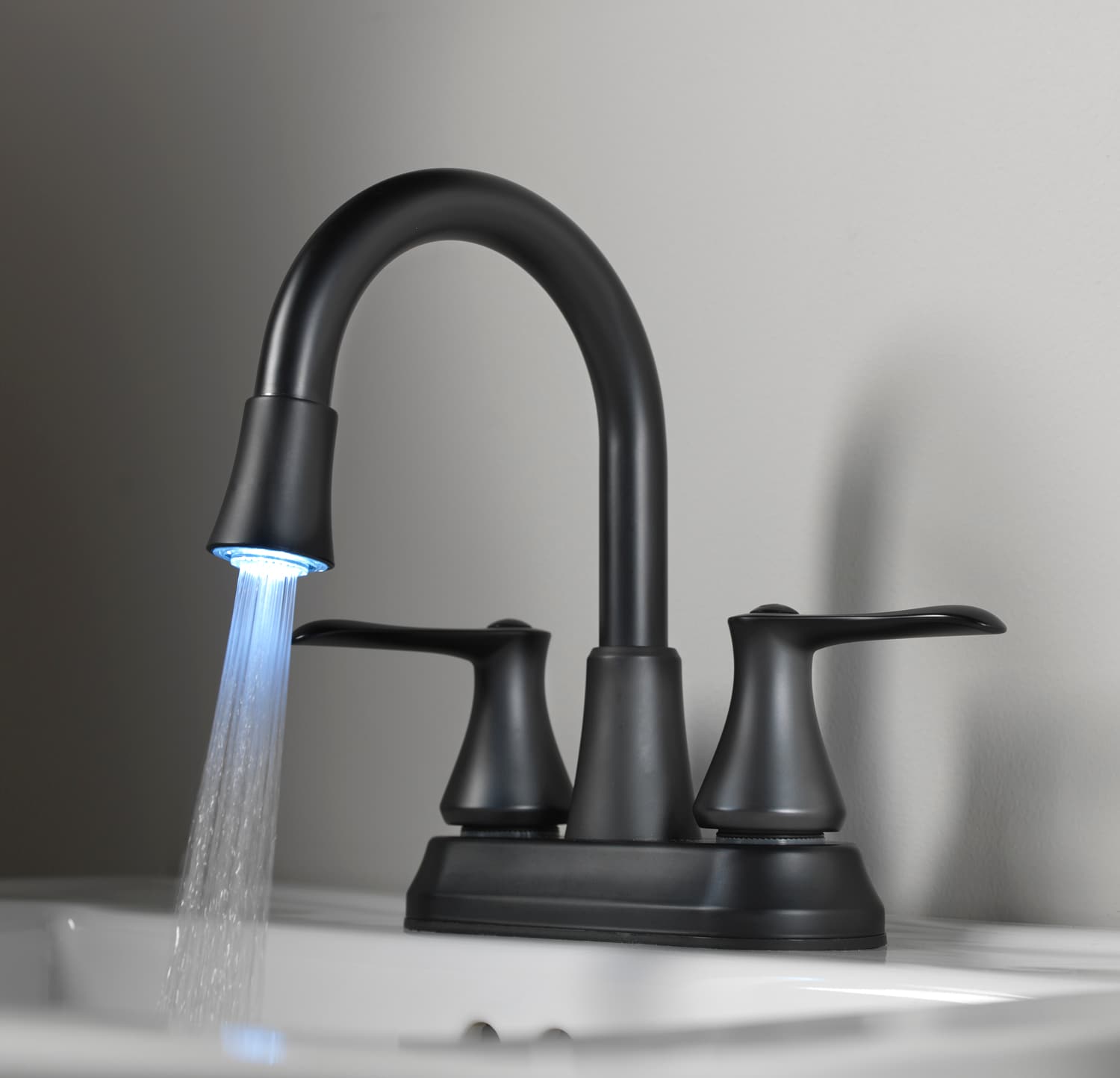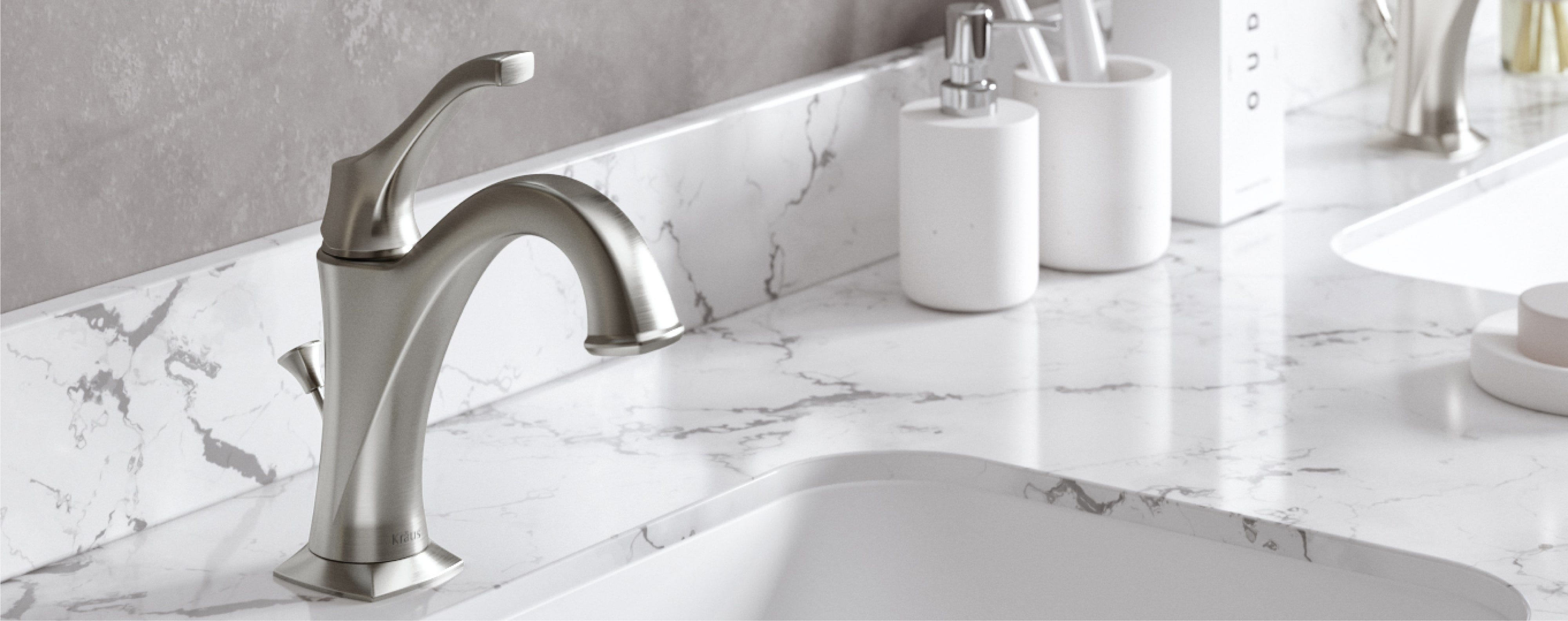Centerset Bathroom Faucet Basics
Centerset bathroom faucets are a popular choice for their classic design and ease of installation. They are known for their simple, elegant look and are often found in traditional and transitional bathrooms.
Components of a Centerset Faucet
Centerset faucets consist of several key components that work together to control water flow and temperature.
- Spout: The spout is the part of the faucet that delivers water. It is typically located in the center of the faucet body and is usually made of metal, such as brass or chrome.
- Handles: Centerset faucets have two handles, one for controlling hot water and the other for cold water. The handles are typically located on either side of the spout.
- Cartridge: The cartridge is the heart of the faucet. It is a small, replaceable component that controls water flow and temperature.
- Mounting Plate: The mounting plate is a circular plate that secures the faucet to the sink. It typically has three holes: one for the spout and two for the handles.
Advantages of Centerset Faucets
Centerset faucets offer several advantages over other types of bathroom faucets.
- Ease of Installation: Centerset faucets are relatively easy to install. They typically come with a pre-drilled mounting plate that makes installation a straightforward process.
- Affordability: Centerset faucets are generally more affordable than other types of bathroom faucets, making them a budget-friendly option.
- Classic Design: Centerset faucets have a classic, timeless design that complements a wide range of bathroom styles.
Disadvantages of Centerset Faucets
Centerset faucets also have some disadvantages that are important to consider.
- Limited Functionality: Centerset faucets typically have fewer features than other types of bathroom faucets. They often lack features such as pull-down sprayers or touchless operation.
- Limited Spout Reach: The spout of a centerset faucet is often shorter than the spout of other types of faucets. This can make it difficult to fill large pots or wash your hands without splashing.
- Difficult to Repair: Repairing a centerset faucet can be challenging because the cartridge is often difficult to access.
Centerset Faucet with Drain Assembly: Centerset Bathroom Faucet With Drain Assembly

Centerset faucets with drain assemblies offer a convenient and streamlined solution for bathroom sink installations. These faucets combine the functionality of a traditional centerset faucet with the added benefit of an integrated drain assembly, simplifying the installation process and providing a cohesive aesthetic.
Features and Benefits
Centerset faucets with drain assemblies offer several advantages:
- Simplified Installation: The integrated drain assembly eliminates the need for separate drain components, reducing installation time and complexity.
- Improved Aesthetics: The seamless integration of the faucet and drain creates a clean and unified look, enhancing the overall visual appeal of the bathroom sink.
- Enhanced Durability: The combined design of the faucet and drain assembly ensures a more robust and durable installation, reducing the risk of leaks or malfunctions.
- Variety of Styles: Centerset faucets with drain assemblies are available in a wide range of styles and finishes to complement any bathroom décor.
Installation Process
Installing a centerset faucet with a drain assembly involves the following steps:
- Prepare the Sink: Remove the old faucet and drain assembly, ensuring the sink is clean and free of debris.
- Connect the Water Supply Lines: Attach the hot and cold water supply lines to the faucet, ensuring they are properly secured.
- Install the Drain Assembly: Secure the drain assembly to the sink using the provided hardware, ensuring a tight and leak-proof connection.
- Mount the Faucet: Align the faucet base with the sink holes and secure it using the provided mounting screws or nuts.
- Connect the Drain Pipe: Attach the drain pipe to the drain assembly and secure it to the sink’s drain opening.
- Test for Leaks: Turn on the water supply and check for any leaks around the faucet, drain assembly, and connections.
Types of Drain Assemblies
Centerset faucets with drain assemblies are available with different types of drain mechanisms:
- Pop-up Drain: This classic design features a lever that raises and lowers the drain stopper. It’s simple and affordable, but may require more effort to operate.
- Push-Button Drain: This modern option allows for easy drain control with a simple push of a button. It’s convenient and requires minimal effort.
- Lever Handle Drain: This type of drain assembly features a lever handle that controls the drain stopper, offering a more ergonomic and stylish option.
Choosing the Right Centerset Faucet

Picking the perfect centerset faucet for your bathroom is a bit like choosing the right outfit for a special occasion – it needs to look good, fit well, and be comfortable. You’ll want a faucet that complements your sink, fits your style, and suits your budget.
Key Features to Consider
When choosing a centerset faucet, there are a few key features to consider:
- Finish: Centerset faucets come in a wide range of finishes, from classic chrome and brushed nickel to more modern matte black and oil-rubbed bronze. The finish you choose should complement the other fixtures in your bathroom and your overall design aesthetic.
- Flow Rate: The flow rate of a faucet is measured in gallons per minute (GPM). A higher flow rate means more water will come out of the faucet, which can be helpful for filling a tub or washing dishes. However, a higher flow rate also means using more water, which can increase your water bill. The standard flow rate for bathroom faucets is 1.2 GPM.
- Handle Type: Centerset faucets typically have either lever handles or cross handles. Lever handles are easier to operate, especially for people with arthritis or limited hand mobility. Cross handles are more traditional and can add a touch of elegance to your bathroom.
Installation and Maintenance

Installing a centerset bathroom faucet with a drain assembly can seem daunting, but it’s a project most DIYers can tackle with the right tools and instructions. This section will guide you through the installation process, troubleshoot common issues, and provide tips for keeping your faucet in top shape for years to come.
Installation Steps
Installing a centerset faucet with a drain assembly requires careful attention to detail and proper tools. Here’s a step-by-step guide:
- Turn off the water supply: Locate the shut-off valves for the hot and cold water lines to your sink. Turn them clockwise until they are completely closed.
- Remove the old faucet: Unscrew the old faucet from the sink using a wrench or adjustable pliers. If the faucet is stubborn, you can use a pipe wrench to loosen it, but be careful not to damage the sink.
- Remove the old drain assembly: Remove the old drain assembly by unscrewing the nuts holding it in place.
- Prepare the sink for the new faucet: Clean the sink surface around the faucet holes with a damp cloth to remove any debris or grime.
- Install the new drain assembly: Place the new drain assembly into the sink hole and tighten the nuts to secure it.
- Attach the new faucet to the sink: Place the new faucet over the sink holes and tighten the mounting nuts.
- Connect the water lines: Connect the hot and cold water lines to the new faucet. Use Teflon tape to seal the threads to prevent leaks.
- Turn on the water supply: Slowly turn on the water supply to the faucet and check for leaks. If there are leaks, tighten the connections or replace the Teflon tape.
- Test the faucet: Turn the faucet on and off several times to ensure that it operates smoothly and that there are no leaks.
Troubleshooting Common Issues
Centerset bathroom faucet with drain assembly – During installation, you may encounter some common issues that require troubleshooting. Here are some of the most frequent problems and their solutions:
- Leaking faucet: This is the most common issue. Check the connections for loose nuts or damaged washers. If the problem persists, you may need to replace the faucet cartridge or the entire faucet.
- Faucet won’t turn on: Check that the water supply is turned on and that the shut-off valves are open. If the problem persists, the faucet cartridge may be clogged or damaged.
- Faucet won’t turn off: Check that the faucet handle is properly seated and that the cartridge is not worn out. If the problem persists, you may need to replace the faucet cartridge or the entire faucet.
- Slow water flow: This could be due to a clogged aerator, a partially closed shut-off valve, or a clogged water line.
- Drain assembly leaks: Check that the nuts are properly tightened and that the drain assembly is not damaged. If the problem persists, you may need to replace the drain assembly.
Maintenance Tips, Centerset bathroom faucet with drain assembly
Regular maintenance can extend the life of your centerset faucet and prevent future problems. Here are some tips to keep your faucet in top shape:
- Clean the faucet regularly: Wipe down the faucet with a soft cloth and mild soap to remove any dirt or grime.
- Clean the aerator: Remove the aerator from the faucet spout and soak it in vinegar for 30 minutes to remove mineral deposits.
- Replace the cartridge: If the faucet starts to leak or operate poorly, replace the cartridge.
- Lubricate the faucet handle: Apply a small amount of silicone lubricant to the faucet handle to prevent it from sticking.
- Avoid using harsh chemicals: Avoid using harsh chemicals on the faucet, as they can damage the finish.
